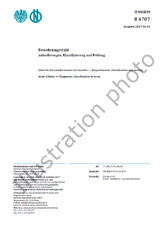We need your consent to use the individual data so that you can see information about your interests, among other things. Click "OK" to give your consent.

ÖNORM EN ISO 10270
Corrosion of metals and alloys - Aqueous corrosion testing of zirconium alloys for use in nuclear power reactors (ISO 10270:2022)
Translate name
STANDARD published on 1.6.2022
The information about the standard:
Designation standards: ÖNORM EN ISO 10270
Publication date standards: 1.6.2022
SKU: NS-1063866
The number of pages: 24
Approximate weight : 72 g (0.16 lbs)
Country: Austrian technische Norm
Category: Technical standards ÖNORM
The category - similar standards:
Annotation of standard text ÖNORM EN ISO 10270 :
Dieses Dokument legt fest: a) die Bestimmung der Massezunahme; b) die Untersuchung der Oberflächen von Produkten aus Zirkonium und Zirkoniumlegierungen nach einer Korrosionsprüfung in Wasser bei 360 °C oder in Dampf bei oder über 400 °C; c) die Durchführung der Prüfungen in Dampf unter einem Druck von 10,3 MPa. Dieses Dokument ist auf Schmiedeprodukte, Gussteile, pulvermetallurgische Produkte und Schweißgut anwendbar. Das Verfahren wurde bereits vielfach zur Entwicklung neuer Legierungen und Wärmebehandlungsverfahren sowie zur Bewertung von Schweißverfahren genutzt. Es ist nicht nur zur Beurteilung des Betriebsverhaltens anwendbar, sondern stattdessen als Ganzes in dem Umfang, der zur Abnahmeprüfung des jeweiligen Produkts festgelegt ist.
We recommend:
Technical standards updating
Do you want to make sure you use only the valid technical standards?
We can offer you a solution which will provide you a monthly overview concerning the updating of standards which you use.
Would you like to know more? Look at this page.



 Cookies
Cookies
